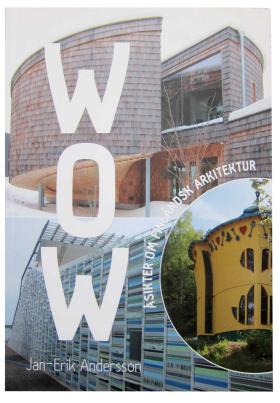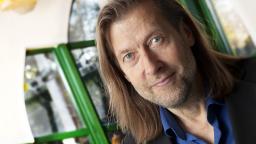
WOW. Ansikter om finländsk arkitektur
(WOW. Opinions on Finland's Architecture)
by Jan-Erik Andersson
reviewed by Kate Lambert
Artist Jan-Erik Andersson, whose works include a bright yellow sauna in the shape of a bulb of garlic, is a man with opinions on Finland’s architecture, not many of which will please the architectural establishment. His book is a call to arms against the sterile, anonymous, uniform and ubiquitous ‘grey boxes’ of Finnish modernism. A heartfelt argument for decoration, colour, emotion and individualism in contemporary architecture, it is illustrated by a thought-provoking whistle-stop tour of buildings in Finland and abroad, to inspire debate on the architecture of the future.
Initially Andersson wonders what Helsinki’s quayside would look like if populated by the buildings from Elsa Beskow’s fairy tales – shaped like a hat, a tent, and something that looks like a potato with eyes, topped by an upturned flowerpot. Could this ever happen, he asks. If not, why not? What is good taste? And who gets to decide?
The journey begins with a bleak bus trip through Helsinki, taking in the Opera (bland, Andersson thinks), Aalto’s Finlandia Hall (Finnish modernism at its best), Saarinen’s National Museum (inspiring towers and façade detail), and a new iconic chapel which, despite being an abstract, windowless ‘blob’ is, at least, a cheerful, bright orange. Andersson blames the minimalist modernist aesthetic for a boring, depressing built environment. His intention is not to impose a new style but to provide real examples of what broad, inclusive architecture might look like, overturning the prevailing imperative of a homogenously uniform cityscape. The next thirty-two short chapters spotlight a wide range of buildings that are variously decorative, idiosyncratic and fun. And, crucially, designed around the people, or, in the case of a barn in the shape of a cumin seed, around the cows who live in them. Plus some other structures that are none of those things.
We are asked to look at a community of cosy, circular, timber-clad Hobbit homes outside Jyväskylä, at brightly coloured buildings in Tirana, at Birmingham City Library with its fascinating facade of interlocking rings that cast changing shadows on the floor of the building, and at a school whose interior decor, designed by the author, tells a story that is now part of the school’s identity. The global tour takes in the Scottish Parliament building, Manrique’s lava bubble houses in Lanzarote, and an extension in the forests of Joensuu designed as a castle with a guillotine on the drive, a cannon on the roof and a torture chamber in the basement. Architects would not consider the latter architecture, but does that matter?
Journey’s end is Life on a Leaf in Turku, the ‘architectural artwork’ in which the author lives with his family. Planned with architect Erkki Pitkäranta as the study project for Andersson’s doctorate in Fine Arts, this three-dimensional thesis has windows shaped like droplets, hearts and leaves, an interior whose leaf-shaped curving surfaces are decorated with colourful mosaics, and a bluebell-shaped cupola on the roof.
The book describes so many buildings that more photos would have been welcome, given that the argument is all about visual decoration and the thoughts and feelings evoked by buildings in which art is integral. Captions underneath the pictures rather than at the end of the book would avoid constant flicking backwards and forwards. But once you know which one is which, the examples raise provocative questions. Why are ‘clean’, unembellished buildings more ‘timeless’ than decorated ones? Why is modernism modern when it began in the 1920s? And why do committees persist in awarding prizes to grey concrete boxes?
Some of the assumptions Andersson rails against – wooden buildings being associated with outside toilets and a lower living standard, and the consequent desire to raze them to the ground in a spirit of consistently uniform modernity – may be peculiar to Finland, but others – planning committees as the arbiters of good taste with the power to decide what can and can’t be built – are familiar to anyone who has ever watched Grand Designs. His view that architecture should tell stories, invoking dreams, imagination, nature, and joy, and his call for a paradigm shift in the way architects are trained, might not go down well everywhere but are persuasive nonetheless. As is the thought that humans can’t live by abstract, logical rationality alone, they need emotions too, in surprising and inspiring buildings that make us say ‘Wow’!

WOW. Ansikter om finländsk arkitektur
Schildts & Söderströms, 2014. 115 pages.
